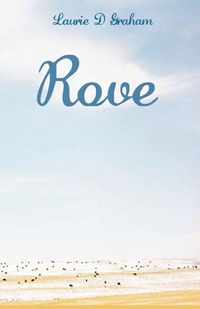Reviews
Poetry Reviews
by Michael Greenstein
Laurie D. Graham, Rove (Regina: Hagios, 2013). Paperbound, 88 pp., $18.
Deena Kara Shaffer, The Grey Tote (Montreal: Signal, 2013). Paperbound, 66 pp., $16.
 Laurie D. Graham’s Rove, an ambitious and accomplished book-length poem, joins a chorus of prairie odysseys. This debut collection, dedicated to “Family,” includes her immediate family as well as a more extended family of poets, from Jan Zwicky and Andy Suknaski to Michael Ondaatje, Dionne Brand, and Tim Lilburn. Beyond these Canadian influences, one can find traces of Whitman and Hopkins. Instead of leaves of grass, we have cloverleaf and fescue; instead of Whitman’s “I sing,” Graham opens with “Say cloverleaf, polyethylene. / Say this parking lot slinks into marshland. Say it bristles into scrubland.” Her long lines in unrhymed roving couplets differ from Hopkins’ “rove-over” sprung rhythm, but still flow through complex soundscapes, the initial incantatory monosyllables replacing end-line rhyme. These paired lines measure the roving distance: “Say Alberta and Saskatchewan / and switch the order.” Graham’s imperatives, such as “send it through the layers,” create a series of palimpsests with modern suburbia paving over an earlier agricultural community. The layered landscape of cloverleaf highway, polyethylene grocery sack, muck in the marsh, and bristling parking lot comprise a sonic range from silence to the barbaric yawp of “sing the combustion engine, / say the singing of your name in the new air.”
Laurie D. Graham’s Rove, an ambitious and accomplished book-length poem, joins a chorus of prairie odysseys. This debut collection, dedicated to “Family,” includes her immediate family as well as a more extended family of poets, from Jan Zwicky and Andy Suknaski to Michael Ondaatje, Dionne Brand, and Tim Lilburn. Beyond these Canadian influences, one can find traces of Whitman and Hopkins. Instead of leaves of grass, we have cloverleaf and fescue; instead of Whitman’s “I sing,” Graham opens with “Say cloverleaf, polyethylene. / Say this parking lot slinks into marshland. Say it bristles into scrubland.” Her long lines in unrhymed roving couplets differ from Hopkins’ “rove-over” sprung rhythm, but still flow through complex soundscapes, the initial incantatory monosyllables replacing end-line rhyme. These paired lines measure the roving distance: “Say Alberta and Saskatchewan / and switch the order.” Graham’s imperatives, such as “send it through the layers,” create a series of palimpsests with modern suburbia paving over an earlier agricultural community. The layered landscape of cloverleaf highway, polyethylene grocery sack, muck in the marsh, and bristling parking lot comprise a sonic range from silence to the barbaric yawp of “sing the combustion engine, / say the singing of your name in the new air.”
Names overlap: Graham’s Ukrainian and Polish roots—Bolishi, Moatiski, Drogowich—settle on Cree land and language—néhiyawak, paskwâwimostos. She offers us “birch” in English, Ukrainian, Mischif, French, and Cree. She inherits grief along with a Cyrillic past. Lyric and narrative family histories include roving packs of musicians and doctors, who “rove away.” Ancestral suffering goes back to the Cossacks persecuting her great-grandmother. Family lines, lines of poetry, “slow-curving lines from A to B,” and “line splitting road from ditch,” all intersect in Rove’s quickened cadences. As modernization bends prairie wilderness and western perspectives, Graham tells it slant, aligning multilingual signs with startling metaphors. We gaze into the distance, while “incantatory stoplight timers of the heart lurch out of whack.” The poet presses melodies and visions through synaesthesia. Her domestic gaze combines “Cacophony of throat and ribcage; the lodged / song out of tune.” Memory fills loss, absence, silence: “And all the fields recalled with a roving, / improvised clarity.” Toward the end of Rove, the horizon narrows to a hospital and the grief of mothers. Modern feminism challenges traditional religion. “Stress, the echo chamber of the ex-Catholic.” As guilt and grief rove and reverberate, Graham shores up distances: “Even from a great distance, what doesn’t leave is intonation, / which syllables you lean on.” The straight line unravels, trees get felled, but Graham props up spavined structures with her exact intonation, kinetic tapestries and tropes: “Silence swarming with intention. / Getting back on the tow-rope of time.”
As in Rove’s ending, in a hospital ward, Deena Kara Shaffer’s first book, The Grey  Tote, focuses on the death of parents. Where Graham tends to the horizontal and expansive, Shaffer’s triptych is more vertical and compact, with the exception of her opening poem, “Death Traps.” “A big woods loop of solitude and freshness. / Killarney’s ambled roaming and balsam-smell.” If “ambled roaming” appears redundant, the phrase, with its expansiveness and mix of olfactory waft, is rewarding. “Loops” may be key to Shaffer’s quests: her syntax frequently loops in clever patterns and reversals that startle the reader with fresh perception. Witty loops depend on chiasmus or reversal of word order, as the poet explores the range of lost and found. “Miles of wild blueberries: what I’d been after. / After me: moss’ treachery underfoot.” The balance of after and before, less and more (“Less like ferns and boulders, more like death traps”) reveals the poet’s precarious situation. Death traps hint at the pun in “grey tote”—a container of mortality. “The Grey Tote: Mum” describes her mother’s birthing bag: “Cylindrical utility with simple handles.” This looped container is juxtaposed with “The Grey Tote: Dad”—“Nylon, one zipper. Nothing reflective”—and followed by “The Grey Tote: Grandfather,” a reversal of family history.
Tote, focuses on the death of parents. Where Graham tends to the horizontal and expansive, Shaffer’s triptych is more vertical and compact, with the exception of her opening poem, “Death Traps.” “A big woods loop of solitude and freshness. / Killarney’s ambled roaming and balsam-smell.” If “ambled roaming” appears redundant, the phrase, with its expansiveness and mix of olfactory waft, is rewarding. “Loops” may be key to Shaffer’s quests: her syntax frequently loops in clever patterns and reversals that startle the reader with fresh perception. Witty loops depend on chiasmus or reversal of word order, as the poet explores the range of lost and found. “Miles of wild blueberries: what I’d been after. / After me: moss’ treachery underfoot.” The balance of after and before, less and more (“Less like ferns and boulders, more like death traps”) reveals the poet’s precarious situation. Death traps hint at the pun in “grey tote”—a container of mortality. “The Grey Tote: Mum” describes her mother’s birthing bag: “Cylindrical utility with simple handles.” This looped container is juxtaposed with “The Grey Tote: Dad”—“Nylon, one zipper. Nothing reflective”—and followed by “The Grey Tote: Grandfather,” a reversal of family history.
These heirlooms evolve in “The Grey Tote: Dad, PT. II,” where her grandfather’s name is crossed out and her father’s name underlined above it for his palliative stay: “The side panel ready to ink in the next name.” A similar demise occurs in “The Grey Tote: Mum, PT. II,” which describes her mother’s tumours, and concludes: “A generational satchel, waiting.” Shaffer’s inheritance appears in “The Grey Tote: Me”: “Now, my miscellany bag …. / the tote sits buried in the closet’s corner, / behind anything that can be put in front.” Balance, inversion, pivots, and loops lie at the heart of Shaffer’s “twists of sickness.” In “The Homeopath” the search for totality and remedies of connection ends in characteristic chiasmus: “With subtle takes on it all, / she takes it all on.” Balance and parallelism recur in “More or Less” and “To Where the Clutch Lessens” (“to when poise and terminality coexist”). The final poem, “The Five Stages’ Six Losses,” summarizes her quest for equilibrium in the face of her parents’ deaths: “Lists of lifelines: a fatal double-cross.” Syntactic reversals mitigate parental loss: “Drafting the after, / one eye on beyond.” Form fuses with subject: “Losing the two / to analgesic drifts: / lessons in goodbye. Sentences / cut.” Taut, elastic, and supple sentences inform Rove and The Grey Tote’s drift. Graham uses metaphor, Shaffer the metonymy of containers, and both unconventional elegies traverse lines and lineage to transcend grief and loss.
—Michael Greenstein









